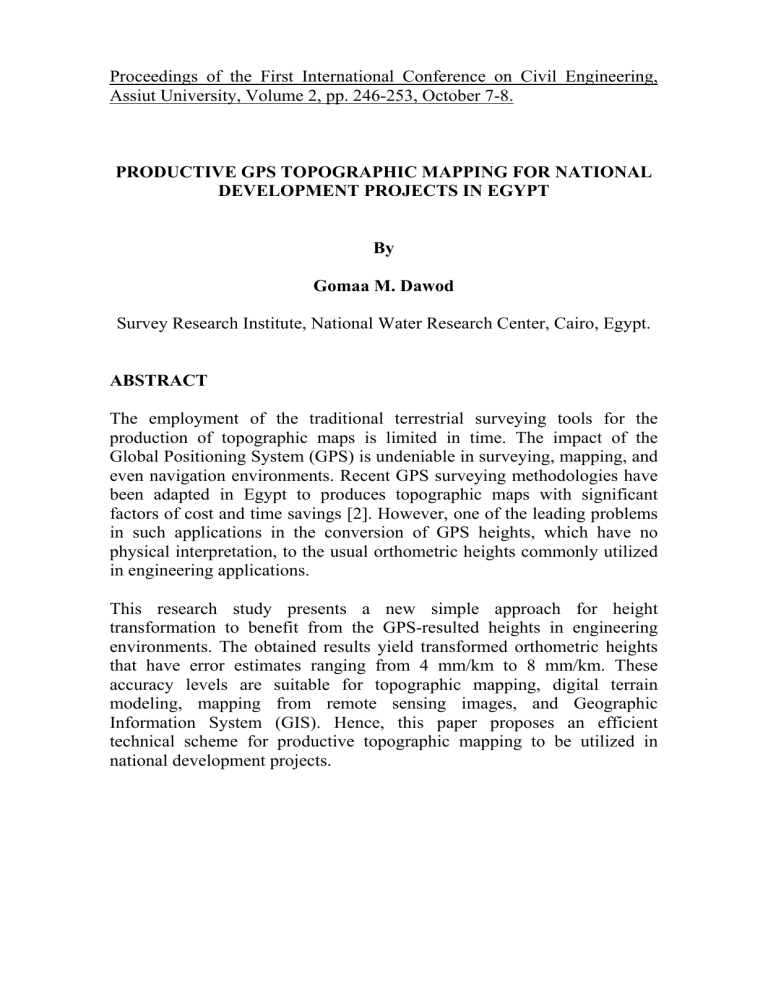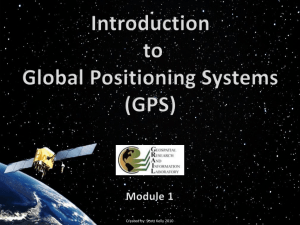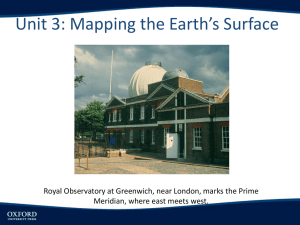030 Productive GPS topographic Mapping for National Development

Proceedings of the First International Conference on Civil Engineering,
Assiut University, Volume 2, pp. 246-253, October 7-8.
PRODUCTIVE GPS TOPOGRAPHIC MAPPING FOR NATIONAL
DEVELOPMENT PROJECTS IN EGYPT
By
Gomaa M. Dawod
Survey Research Institute, National Water Research Center, Cairo, Egypt.
ABSTRACT
The employment of the traditional terrestrial surveying tools for the production of topographic maps is limited in time. The impact of the
Global Positioning System (GPS) is undeniable in surveying, mapping, and even navigation environments. Recent GPS surveying methodologies have been adapted in Egypt to produces topographic maps with significant factors of cost and time savings [2]. However, one of the leading problems in such applications in the conversion of GPS heights, which have no physical interpretation, to the usual orthometric heights commonly utilized in engineering applications.
This research study presents a new simple approach for height transformation to benefit from the GPS-resulted heights in engineering environments. The obtained results yield transformed orthometric heights that have error estimates ranging from 4 mm/km to 8 mm/km. These accuracy levels are suitable for topographic mapping, digital terrain modeling, mapping from remote sensing images, and Geographic
Information System (GIS). Hence, this paper proposes an efficient technical scheme for productive topographic mapping to be utilized in national development projects.
1. INTRODUCTION
GPS provides three-dimensional coordinates with respect to the defined global World Geodetic System 1984 (WGS84). Concerning heights, GPS yields ellipsoidal heights (h) that are unlikely be used for practical surveying or engineering applications, as they have no physical meaning.
For instance, when using this type of heights there is the possibility that water will appear to flow up-hill because the physical force of gravity is not considered. On the other hand, orthometric heights (H), which are used in practice, are related to the geoid surface. The geoid is the equipotential or level surface that is closely associated with the Mean Sea Level (MSL) on a global basis. Thus, a transformation is required to convert ellipsoidal heights into orthometric ones. This transformation implicitly describes the relationship between WGS84 and the geoid (Figure 1). On a global scale, the geoid departs from the WGS84 ellipsoid by approximately 100 meters, ranging from about –30 meters to about +70 meters [5].
It has been demonstrated that GPS kinematic techniques reduces the time and costs of topographic map production by considerable factors [2, and 3]
However, this production process encounter the problem of height transformation. There are mainly two approaches in converting the ellipsoidal height into the orthometric one. These include the utilization of a global or national geoid model, and interpolation between geometricallyderived geoid undulations where both h and H have been measured. The second approach is the main aim of this research study, since the first one has several limitations in Egypt as will be discussed in the following section.
2. THE STATUS OF THE GEOID MODELING IN EGYPT
The determination of the geoid has become a main objective for the geodetic community in Egypt for several decades. Several local and nationwide geoid models have been developed in Egypt. The first countrywide geoid solution for Egypt, relative to WGS72 geocentric geodetic datum, using heterogeneous geodetic data has been developed in 1986 [1]. In this pioneer geoid, several sources of geodetic data have been combined, such as terrestrial gravity measurements, Doppler observations; and astronomical observations. Shaker et al [10] have developed a combined
GPS/Gravity geoid model for the Eastern Desert region. Dawod [4] has developed two national geoid models relative to WGS84: a gravimetric model (SRI-GEOID98A) based on the OSU91A global geopotential model of the Earth, and an integrated GPS/Gravity geoid solution (SRI-
GEOID98B). The most recent and accurate geodetic measurements have been utilized in the development of these models, especially the data of the
2
Egyptian National Gravity Standardization Network (ENGSN97) and the
GPS High-Accuracy Reference Network (HARN95). The SRI-GEOID98B model gives geoid undulation (N) varying from 7.22 meters at Abu-Simbol to 22.55 meters at Balteem, with the mean of 15.31 meters.
Recently, two high resolution national geoid models for Egypt (32 o
<latitude> 22 o
, 37 o
<longitude> 25 o
) have been developed based on the utilization of the Earth Geopotential Model (EGM96) as the most recent long-wavelength representation of the Earth geopotential, incorporated with the recent precise geodetic data base available in Egypt [7]. Both
EGM96 and OSU91A were used to compute the geoid undulations over
195 known GPS/Levelling stations. The obtained results show that the mean and RMS values of EGM96 undulations exhibit a better consistency with the measured undulations than the OSU91A corresponding values.
The first 5’x5’ geoid solution, called SRI2001A, is a gravimetric geoid model utilizing 240 first-order gravity stations, a local Digital Elevation
Model (DEM); and the EGM96 in a remove-compute-restore Fast Fourier
Transform (FFT) processing methodology. The most recent national combined geoid model for Egypt is the second 5’x5’ geoid model, called
SRI2001B. It has been developed based on integrating the gravimetric
SRI2001A geoid model to an undulation datum defined by GPS/Levelling observed undulations on a national scale. SRI2001B has a minimum undulation value of 9.44 m and a maximum value of 21.39 m with an average of 13.62 m [ibid].
It worth mentioning that the present amount and distribution of geodetic data sets in Egypt is not reliable enough to produce a detailed national geoid model. For instance, the average station separation for the ENGSN97 gravity network is approximately 66 km, while the average baseline length of the GPS HARN95 network is about 200 km. Furthermore, in some regions over the Egyptian territory there exist a good distribution of geodetic data but with less accuracy level, such as in the Eastern desert [4].
Hence, the interpolation approach may be useful in small areas.
3
Figure 1: Height Systems
3. INTERPOLATION TECHNIQUES TO OBTAIN
ORTHOMETRIC HEIGHTS
Several strategies have been suggested for the interpolation of geoid heights or undulation differences. Smith and Roman [11] have developed a conversion surface that comprises the differences between both height datums for the United States. Saad [8] has suggested several formulas to convert ellipsoidal to orthometric heights. Other research studies [e.g., 6] proposed the usage of a lower-order polynomial surface to model the errors of geoid models in local areas. The least-square collocation technique is also proposed to model geoid errors in relatively small areas [9] As mentioned earlier, the density and accuracy of geoid models in Egypt are not appropriate to attain reasonable accuracy in small areas. Even more, the current study aims to develop a simple scheme that is easy to be applied on a small scale, and helpful in increasing the productivity of contour mapping. Hence, the following technique is suggested and being investigated. A comparable scheme has been presented in a similar research to interpolate geoid undulations [5].
The basic relationship between the three quantities in hand is:
H = h – N (1) which in a differential sense becomes:
H
1
– H
2
= h
1
– h
2
– (N
1
– N
2
)
4
i.e.,
Δ
H =
Δ h -
Δ
N (2)
For a very small area, it can be assumed that the geoid may be approximated by a flat surface. In this case, linear interpolation can be utilized to estimate geoid undulation differences. For medium profiles
(longer than a few kilometers), another more efficient interpolation technique may be suggested as:
N = N o
+ N
1
e + N
2
n (3)
Where the coefficient N o
represents a bias, N
1
and N
2
represent tilts of the geoid plane with respect to the WGS84 ellipsoid, e is the easting and n is the northing on a plane coordinate system.
In order to solve equation (3) and estimate the three unknown parameters
N o
, N
1
, and N
2
, GPS observations should be made at a minimum of three benchmarks that surround the survey area. Hence, three formulas of equation (3) are formed for the GPS/Levelling stations A, B, and C, which in a matrix notation can be written as:
N
0
1 e
A
n
A
-1
N
A
N
1
= 1 e
B
n
B
N
B
N
2
1 e
C
n
C
N
C
(4)
If more than three GPS/Levelling stations are used, equation (4) becomes over-determined and the least-squares adjustment technique is performed to come up with unique un-biased estimates of the three parameters.
4. DATA AND RESULTS
Twenty six GPS/Levelling stations are established in a profile, where the average station separation is about 4.3 km. Three different scenarios have been investigated to validate the accuracy of interpolating geoid heights using the presented approach. The obtained results are summarized in
Table 1.
In the first case, only thirteen points (a point out of every two successive points) have been utilized to solve equation (4). The average distance between these points became about 8 km. The remaining points have been reserved for checking and validation purposes. The estimated parameters are:
5
N o
= 13.825 m, N
1
= 0.00003105, and N
2
= 0.00000297
The obtained results have been used to interpolate geoid heights, and consequently compute orthometric heights, for the check points. Errors between known and interpolated orthometric heights are computed. These errors have an average value of 2.9 cm. In the second scenario, only seven points (a point out of every three successive points) are used in the leastsquare estimation process. The average station separation has changed to approximately 12 km. The obtained errors over the check points have a mean of 7.2 cm. The estimated values of the unknowns are:
N o
= 15.852 m, N
1
= 0.00001669, and N
2
= 0.00000898
In the third investigated case, only five points (a point out of every four successive points) are utilized in the solution of equation (4). The average station separation has changed to approximately 16 km. The obtained errors over the check points have a mean of 12.6 cm. The estimated values of the unknowns are:
N o
= 16.799 m, N
1
= 0.00002398, and N
2
= 0.00003232
Table 1: Results of Geoid Undulation Interpolation
1
2
3
Stations
13
7
5
Average
Distance
(km)
8
12
16
N o
Estimated Parameters
13.825
15.852
16.799
N
1
3105 x10
-8
1669 x10
-8
2398 x10
-8
N
2
297x10
-8
898 x10
-8
323 x10
-8
Average
Error
(cm)
2.9
7.2
12.6
In order to realize these results in a more convenient way, the accuracy may be evaluated in the relative form of mm/km. The above mentioned three cases give estimates equal to 4 mm/km, 6 mm/km, and 8 mm/km respectively. There are several engineering applications that do not require high accuracy of orthometric heights, and hence could be benefit from the presented approach to convert GPS heights to orthometric heights. Some of these applications are: mapping for preliminary planning, digital terrain modeling, mapping from remote sensing images, and Geographic
Information System (GIS).
5. PRODUCTIVE TOPOGRAPHIC MAPPING SCHEME
It worth mentioning that recent modified GPS techniques (especially the on-the-fly method) increase the productivity and decrease the costs and
6
time needed for topographic mapping of large areas, as in the South Valley
(Toshka) development project [2]. In that study, topographic maps for an area of 75,000 feddans (approximately 315 million squared meters) have been developed. This comprised the production of 50 topographic maps of scale 1:5,000 with a contour interval of 1 meter. Each map covers a 3x2 km piece of land whose area is 1500 feddans. A modern productive technique was suggested and implanted, in which the field data campaigns consists of three types of geodetic observations, namely static GPS, OTF relative kinematic GPS; and levelling. An integrated processing strategy has been, also, developed. The current developed simple height transformation scheme can be utilized within that productive strategy in order to obtain orthometric heights needed for contour mapping. In order to convert GPS heights to the corresponding orthometric values, the total area is divided into 3x3 km blocks. At least 3 GPS/Levelling stations should be established in each block. Static, or even Rapid Static, GPS modes are utilized to get accurate GPS positions for these stations. Spirit differential levelling is performed to obtain their orthometric heights. Hence, the presented approach is utilized to estimate the bias and tilts unknown parameters. The computed unknowns are, then, used to convert the ellipsoidal heights of other GPS epochs to orthometric heights, and the contour map is generated.
6. CONCLUSIONS
Recent techniques of the GPS satellite technology have increased the production level of topographic mapping, especially in national development projects in Egypt. GPS provides ellipsoidal heights relative to the WGS84 global ellipsoid. This type of heights does not have the physical meaning we need in geodetic applications. Orthometric heights, relative to the Mean Sea Level, are the most common height type used in the Ministry of Water Resources & Irrigation and in all other engineering applications. An approach of converting GPS heights to orthometric heights has been developed. The obtained results show that the accuracy estimate of this technique is enough for several applications as: topographic mapping, digital terrain modeling, mapping from remote sensing images, and Geographic Information System (GIS). The integration of recent GPS observation methods (as the on-the-fly method) and the approved height conversion approach used for the production of topographic maps in national projects in Egypt.
REFERENCES
[1] Alnaggar, D., 1986, Determination of the geoid in Egypt using heterogeneous geodetic data, Ph.D. dissertation, Faculty of
Engineering, Cairo University, Cairo, Egypt.
7
[2] Alnaggar, D., and Dawod, G., 1999, Efficiency of GPS techniques in national applications, Proceedings of the International Conference on
Integrated Management of Water Resources in the 21 st
Century, Cairo,
November 21-25, Volume II, pp. 741-752.
[3] Dawod, G., 2002, Utilization of modern GPS techniques to estimate depressions volumes for water resources management, Water Science
Magazine, October.
[4] Dawod, G., 1998, A national gravity standardization network for Egypt,
Ph.D. Dissertation, Shoubra Faculty of Engineering, Zagazig
University, Cairo, Egypt.
[5] Featherstone, W., Dentith, M., and Kirby, J., 1998, Strategies for the accurate determination of orthometric heights from GPS, Survey
Review, No. 267, pp. 278-296.
[6] Martensson, S., 2002, Height determination by GPS: Accuracy with respect to different geoid models in Sweden, FIG XXII International conference, Washington, D.C., USA, April 19-26.
[7] Saad, A., and Dawod, G., 2002, A Precise Integrated GPS/Gravity
Geoid Model for Egypt, Civil Engineering Research Magazine
(CERM), Al-Azhar University, V.24, No. 1, pp..
[8] Saad, A., 1998, Productivity analysis for obtaining orthometric heights without levelling in Egypt, CERM V. 20, No. 3, pp.430-440.
[9] Seker, D., and Yildirim, A., 2002, Orthometric height derivation from
GPS observations, FIG XXII International conference, Washington,
D.C., USA, April 19-26.
[10] Shaker, A., Saad, A., and El Sagheer, A., 1997, Enhancement of the
Egyptian gravimetric geoid 1995 using GPS observations, Proceedings of the International Symposium on GIS/GPS, Istanbul, Turkey, Sept.
15-19.
[11] Smith, D., and Roman, D., 2001, GEOID99 and GS99SSS: 1-arcminute geoid models for the United States, Journal of Geodesy, V. 75,
No.9, pp. 469-490.
8



